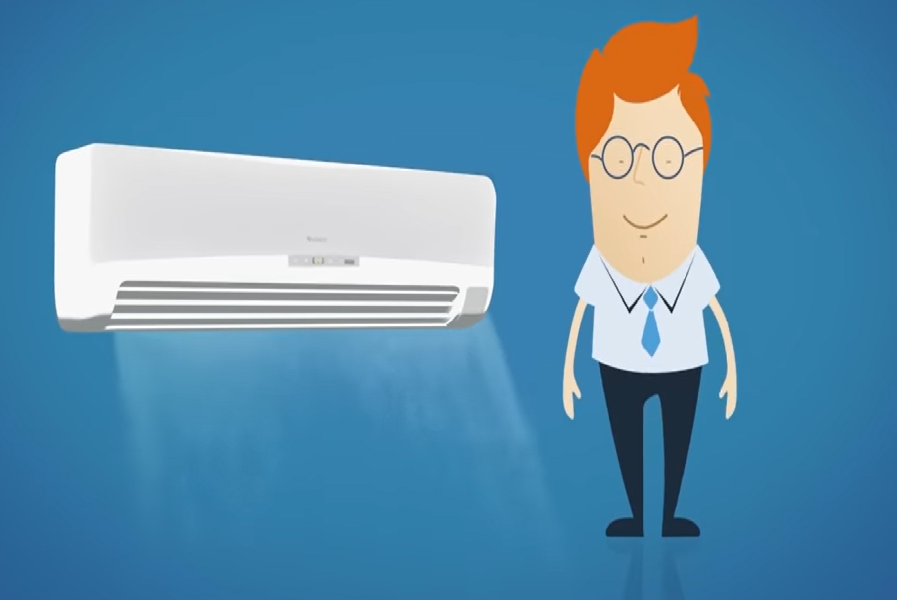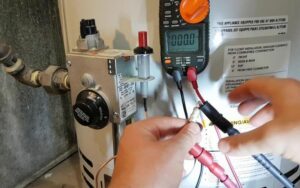A mini-split system is an HVAC (heating, ventilation, and air conditioning) system that doesn’t need ductwork to transport air. It is sometimes referred to as a ductless air conditioning or heating system. Instead, mini-split systems use small indoor units mounted on walls or ceilings connected to an outdoor unit by a conduit. This conduit contains the refrigerant tubing, power cable, and drainage line.
Table of Contents
ToggleMini-split systems are often used in homes or commercial buildings where ductwork is not feasible or when a more targeted heating or cooling solution is needed. They are a well-liked option for consumers and companies since they are sustainable, quiet, and relatively easy to install.
In this article, we’ll explore what is a mini split, Its options and its main features. Let’s get started.
Also check: How does a Mini Split System Work?
Single-Zone Versus Multi-Zone Ductless Systems
Ductless mini-split systems come in two main types:
- Single-zone mini split system
- Multi-zone mini split system
Some significant distinctions between the two may make one more ideal for your needs than the other, even though both offer benefits over conventional HVAC systems that employ ductwork.
Single-Zone Systems
As the name suggests, single-zone ductless systems are designed to heat or cool a small apartment or area. A refrigerant line connects an interior unit and an outdoor unit, which comprise the units. The indoor unit is often located on the room’s wall or ceiling and is managed by a wall- or remote-controlled thermostat.
Single-zone ductless systems are a perfect choice for homeowners who wish to add heating or cooling to a space without existing ductwork. They are also ideal for rooms that are difficult to cool or heat with traditional HVAC systems, such as a sunroom or a converted attic or garage.
Advantages of Single-Zone System
- One of the main advantages of a single-zone ductless system is that it allows for greater energy efficiency, as you only have to heat or cool the room you are using rather than the entire house. Over time, this can cut your energy expenditures, allowing you to save funds.
- Another advantage is how easy it is to install them. Because there is no ductwork involved, Installation is relatively quick and doesn’t require any major renovations to your home. This makes single-zone ductless systems a cost-effective and convenient option.
Multi-Zone Ductless Systems
Multi-zone ductless systems, on the other hand, are designed to heat or cool multiple rooms or zones using a single outdoor unit. They comprise many indoor units, a refrigerant line, and an outdoor unit. Each indoor unit may be controlled independently, allowing you to set the temperature in each zone or space how you like it.
This allows for greater flexibility and comfort, as each person in the house can set the temperature to their liking. Oversized residential or commercial properties with multiple spaces or portions that need heating or cooling are best suited for multi-zone ductless systems. They are also a good option for homeowners who want to upgrade their existing HVAC system to a more energy-efficient and cost-effective system.
Advantages of Multi-Zone System
One of the main advantages of a multi-zone ductless system is that it allows for greater energy efficiency. Your energy consumption can be decreased, and you can cut your energy costs by just heating or cooling the rooms that are being used.
A disadvantage of the Multi-Zone System
However, one potential disadvantage of a multi-zone system is that it can be more expensive to install than single-zone systems due to the additional indoor units and refrigerant lines that are required. Additionally, if one indoor unit develops a problem, it can affect the entire system, which may require more extensive repairs.
Components of Mini-split System
A mini-split system, also known as a ductless air conditioning or heating system, is composed of several components that work together to provide heating or cooling to a home or building. The essential elements of a small split system are as follows:
External Unit (Mini Split Condenser)
The core of the small split system is the outside unit. It houses a compressor, which compresses the refrigerant throughout the system. The outdoor unit also houses the condenser coil and the fan, which helps to dissipate heat and release it into the outside air.

Indoor Unit
The indoor unit delivers heated or cooled air to the room or zone where it is installed. It consists of an evaporator coil, a fan, and a filter. The fan circulates the cooled air back into the room as the evaporator coil absorbs heat from the space and transmits it to the refrigerant.
Lines for Refrigerant
The interior and outdoor units are connected by refrigerant lines. These lines comprise the refrigerant that transfers heat from indoor to outdoor units.

Power Cable / Wiring
A power cable connects the outdoor unit to an electrical outlet.
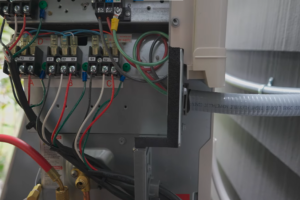
Drainage Line
A drainage line is used to remove condensate water that is produced by the indoor unit. This line is usually connected to a drain or an outdoor location where the water can be safely disposed of.
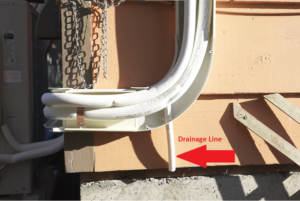
Remote Control
A control system adjusts the inside unit’s parameters and temperature. Several small split systems can be controlled from a mobile device via smartphone apps.

Mounting Brackets
Mounting brackets secure the indoor unit to the wall or ceiling. Overall, mini-split systems comprise several components that work together to provide efficient and effective heating and cooling to a home or building. Depending on the mini split system’s maker and model, the parts and their arrangement may change.

How does a Mini-Split System Works?
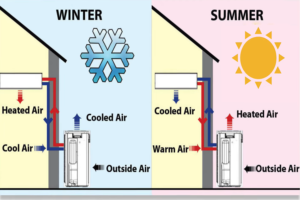
The working principle of a mini-split system is based on the same principles as a traditional HVAC system but with a few key differences. This is how it operates:
Cooling Mode
The refrigerant in the mini-split system absorbs heat from the inside air and transmits it to the outside unit while it is in cooling mode. The outdoor unit then dissipates the heat into the outside air while the cooled refrigerant flows back to the indoor unit.
The interior unit then blows the evaporative cooling back into the surrounding region. When the mini-split system is set to heat, the procedure is carried out in the opposite direction. The refrigerant transmits heat from the outdoor air to the inside unit. The interior unit then blows the heated air back into the room.
Air Filtration
Mini-split systems heat and cool space and purify the air. The indoor unit contains a filter that removes dust, pollen, and other contaminants, improving indoor air quality.
Zoning
Mini-split systems also allow for zoning, meaning different rooms or zones can be heated or cooled independently. Since each interior unit has its thermostat, it is possible to regulate the temperature precisely and use less energy.
Overall, the working principle of a mini-split system is based on the transfer of heat using refrigerant but with the added benefits of air filtration and zoning. This makes mini-split systems popular and efficient for heating and cooling homes and buildings.
Also check: Mini Split vs Central Air Conditioning System
Options for Mini Split Systems
Depending on your requirements and tastes, you have various options for mini-split systems. The most popular choices are listed below:
Single versus Multiple Zones
While multi-zone systems can heat or cool many rooms or zones with a single outdoor unit, single-zone mini split systems are intended to heat or cool a single room or zone. Despite costing more than single-zone systems, multi-zone systems offer more flexibility and efficiency.
Wall-Mounted vs. Ceiling-Mounted
Mini split indoor units can be mounted on the wall or ceiling, depending on your preferences and the room’s layout. Wall-mounted units are more common and are easier to install, while ceiling-mounted units can be more discreet and provide even more airflow.


SEER Rating
A system’s energy consumption is gauged by its seasonal energy efficiency ratio or SEER. Mini split systems typically have SEER ratings between 13 and 30, with higher ratings indicating greater energy efficiency. Choosing a system with a higher SEER rating can help you save money on energy bills in the long run.
Heat Pump vs. Cooling-Only
Mini split systems can be either heat pumps, which can provide both heating and cooling or cooling-only systems, which only provide cooling. Heat pumps are more expensive than cooling-only systems but can provide year-round comfort and energy efficiency.
Inverter vs. Non-Inverter
Inverter mini-split systems use variable-speed compressors that adjust their output based on the room’s temperature needs. This makes them more energy-efficient and quieter than non-inverter systems with fixed-speed compressors.
Floor-Mounted Mini Splits
Floor-mounted mini-split systems are designed to be mounted on the floor and can provide heating and cooling to a single room or zone. They are often used in areas with limited walls or ceilings, such as small offices or bedrooms. Floor-mounted mini splits are available in single-zone and multi-zone configurations and can be either heat pumps or cooling-only systems.

Ducted Mini Splits
Ducted mini-split systems are designed to be installed in a home or building’s existing ductwork. They can provide heating and cooling to multiple rooms or zones and be more discreet than traditional ducted systems. Ducted mini splits are available in single-zone and multi-zone configurations and can be either heat pumps or cooling-only systems.
Portable Mini Splits
Portable mini-split systems are designed to be moved from room to room and can provide heating and cooling to a single room or zone. They are frequently utilized in small apartments or dorm rooms when an ongoing setup is impossible. Portable mini splits are available in single-zone and multi-zone configurations and can be either heat pumps or cooling-only systems.
Multi-Position Mini Splits
Multi-position mini-split systems are designed to be mounted in different orientations, such as horizontal or vertical. They can provide heating and cooling to a single room or zone and be a good option for spaces with a limited wall or ceiling space. Multi-position mini splits are available in single-zone and multi-zone configurations and can be either heat pumps or cooling-only systems.
Smart Features
Some mini-split systems come with smart features, such as smartphone apps or Wi-Fi connectivity, that allow you to control the system from your phone or other devices. These capabilities can be useful and save you money by enabling you to change the temperature remotely.
There are many factors to consider when selecting a mini-split system. Knowing your unique demands and preferences, you may select a reliable and efficient heating, ventilation, and cooling system for your property or structure.
What size mini split do I need?
Mini split systems come in various sizes to accommodate different space coverage needs. The amount of insulation in your home, the size of the room or rooms you wish to heat or cool, and the local temperature will all affect the system size you need.
British Thermal Units (BTU)
Typically, the cooling capacity of mini-split systems, which is measured in British Thermal Units, determines their rating (BTUs). The system’s cooling capacity increases with the BTU rating. A system with a higher BTU rating can cool a larger area, while a system with a lower BTU rating is better suited for smaller rooms. You must calculate the square footage of the room or rooms you wish to heat or cool to choose the proper size for your mini-split system.
You can determine the apartment’s dimensions by multiplying them together. Once you have the square footage, you can consult a sizing chart provided by the manufacturer or an HVAC professional to determine the appropriate BTU rating for your mini-split system.
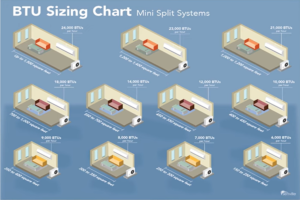
It’s important to note that installing a mini-split system that is too small for the space you want to heat or cool can result in poor performance and increased energy consumption while installing a too-large system can result in short cycling and decreased energy efficiency.
Choosing the right size mini-split system is important for achieving optimal comfort and energy efficiency in your home or building. A competent HVAC technician’s advice helps ensure you select the proper size and kind of system for your unique requirements.
Here’s an example table that shows the mini split size, space coverage, and estimated energy consumption:
| Mini Split Size (BTUs) | Space Coverage (square feet) | Estimated Annual Energy Consumption (kWh) |
| 9,000 | 300 – 450 | 350 – 550 |
| 12,000 | 450 – 550 | 500 – 750 |
| 18,000 | 550 – 1,000 | 800 – 1,200 |
| 24,000 | 1,000 – 1,500 | 1,200 – 1,800 |
| 36,000 | 1,500 – 2,500 | 2,000 – 3,000 |
Note: These are estimates and actual energy consumption can vary based on factors such as climate, insulation, and usage patterns. To choose the best mini-split system for your unique needs and to ensure maximum energy efficiency, it’s crucial to speak with a qualified HVAC technician.
Mini Split Energy Savings
Mini-split systems are known for their energy efficiency, which can lead to significant energy savings over time. Here are some ways that mini-split systems can help you save energy:
Zoning
Mini-split systems allow for zoning, which means that you can heat or cool only the rooms or zones you use. You can save energy by avoiding heating or cooling empty spaces.
Inverter Technology
Inverter mini-split systems use variable-speed compressors that adjust their output based on the room’s temperature needs. This makes them more energy-efficient and quieter than non-inverter systems with fixed-speed compressors.
Energy Star Certification
Many mini-split systems are Energy Star certified, meaning they meet or exceed energy efficiency guidelines set by the US Environmental Protection Agency. By selecting an Energy Star-certified system, you may reduce energy costs and save money.
Ductless Design
Mini-split systems don’t require ductwork to distribute air, meaning there are fewer opportunities for energy loss through leaks or gaps in the ducts.
High SEER Rating
Mini-split systems typically have SEER ratings between 13 and 30, with higher ratings indicating greater energy efficiency. Choosing a system with a high SEER rating can help you save energy and money on your energy bills over time. Choosing the right size and type of system for your specific needs and consulting with a professional HVAC technician can achieve optimal energy efficiency and comfort in your space.
Cost of Mini Split System
A mini-split system’s price can vary based on several variables:
- The system’s size
- The number of interior units
- The Installation’s difficulty
- The system’s brand and model, and others.
Generally, systems are less expensive than multi-zone systems, and larger systems are more expensive than smaller systems.
On average, a single-zone mini-split system can cost between $1,500 and $4,000, while a multi-zone system can cost between $4,000 and $10,000. It’s also important to budget for installation costs, which can range from $500 to $2,000 depending on the complexity of the Installation.
While the upfront cost of a mini-split system can be higher than other types of HVAC systems, the energy savings and efficiency over time can help offset the cost and provide long-term cost savings. the table on mini-split cost with different options
Here’s an example table that shows the estimated cost of mini-split systems with different options:
| Mini Split Options | Estimated Cost Range |
| Single Zone, Cooling Only, 9,000 BTUs | $1,500 – $2,500 |
| Single Zone, Heat Pump, 12,000 BTUs | $2,000 – $3,500 |
| Multi-Zone, Cooling Only, 18,000 BTUs | $4,000 – $6,000 |
| Multi-Zone, Heat Pump, 24,000 BTUs | $6,000 – $10,000 |
| High SEER Rating, Inverter Technology | Additional $500 – $1,500 |
| Professional Installation | $500 – $2,000 |
Note: These are estimates and actual costs can vary based on factors such as location, installation complexity, and the brand and model of the system. It’s essential to consult a licensed HVAC specialist to select the ideal mini-split system for your requirements, Installation, and performance.
Mini-Split Maintenance
Proper maintenance of a mini-split system is important to ensure optimal performance, energy efficiency, and longevity. Here are some maintenance tasks that should be performed regularly:
Clean or Replace Air Filters
The air filters in the indoor unit should be cleaned or replaced every three months to maintain optimal airflow and air quality.
Clean Indoor and Outdoor Units
The indoor and outdoor units should be cleaned regularly to remove dust, dirt, and debris affecting performance and efficiency.
Inspect Refrigerant Levels
To ensure that the refrigerant levels are at the right level for optimum performance, they should be checked once a year.
Check Electrical Connections
Electrical connections should be checked annually to ensure they are secure and corrosion-free.
Check Drainage Line
The drainage line should be checked regularly to ensure that it is free of clogs and that condensate water is flowing properly.
Check Thermostat Settings
The thermostat settings should be checked regularly to ensure they are set to the appropriate temperature and functioning properly.
Schedule Professional Maintenance
It’s recommended to schedule professional maintenance once a year to ensure the system is functioning properly and to address any potential issues before they become bigger problems.
Regular maintenance ensures that your mini-split system operates at peak performance and efficiency. By performing these tasks regularly and scheduling professional maintenance when needed, you can extend the life of your system and save money on energy bills over time.
Residential Applications
Mini split systems are a popular option for residential heating and cooling applications due to their energy efficiency, versatility, and ease of Installation. Here are some of the most common residential applications of mini-split systems:
Single Rooms
Mini-split systems are ideal for heating or cooling a single room or area, such as a bedroom, living room, or home office. They are often used as a supplement to central heating and cooling systems, especially in older homes or buildings that don’t have ductwork.
Whole House Heating and Cooling
Multi-zone mini-split systems can provide heating and cooling to multiple rooms or zones with a single outdoor unit. This can be a cost-effective and energy-efficient option for homes without existing ductwork or unique heating and cooling needs.
Additions or Remodels
Mini split systems can be a great option for home heating and cooling additions or remodeling, such as a garage conversion or a new room addition. They are quick and simple to install and can offer the new room tailored thermal comfort.
Historic Homes
Mini split systems can be a great option for heating and cooling historic homes that don’t have existing ductwork. They can be installed without the need for major renovations and help preserve the home’s character and architecture.
Vacation Homes
Mini split systems can be a great option for heating and cooling vacation homes that are only used seasonally or part-time. They can be turned on and off as needed and can help save energy and money on heating and cooling bills when the home is not in use.
Rental Properties
Mini split systems can be a great option for heating and cooling rental properties, as they can provide individualized heating and cooling to each unit or room. This can be a selling point for renters who value energy efficiency and individualized temperature control.
Commercial Applications
Mini split systems are also popular for commercial heating and cooling applications due to their energy efficiency, flexibility, and ease of Installation. Here are some of the most common commercial applications of mini-split systems:
Small Offices
Mini-split systems can be a great option for heating and cooling small offices, especially in buildings that don’t have existing ductwork. They may supply the workplace area with targeted heating and cooling and are quick and simple to install.
Retail Spaces
Mini split systems can be a great option for heating and cooling retail spaces, such as boutiques or specialty shops. They can be mounted on walls or ceilings and provide efficient and quiet heating and cooling to the space.
Restaurants
In buildings without existing ductwork, mini-split systems can be a wonderful solution for heating and cooling restaurants. They can be installed in the dining area, kitchen, or both, providing individualized temperature control to each area.
Hotels
Mini split systems can be a great option for heating and cooling hotels and motels, especially in rooms that don’t have existing ductwork. They can provide individualized temperature control to each room and can be turned on and off as needed to save energy.
Server Rooms
Mini split systems can be a great option for cooling server rooms, as they can provide targeted cooling to the room without affecting the temperature in the rest of the building. This can lower cooling expenses while improving energy consumption.
Medical and Dental Offices
Mini split systems can be a great option for heating and cooling medical and dental offices. They can provide individualized temperature control to each patient’s room or office. They can also assist in enhancing the purity of indoor air by stripping away allergens and toxins.
Conclusion
Mini split systems are a flexible and effective choice for heating and cooling homes and buildings. They offer several benefits, including targeted heating and cooling, energy efficiency, and improved indoor air quality. With a range of options, including single-zone and multi-zone systems, wall-mounted and ceiling-mounted units, and inverter and non-inverter technology, there is a mini-split system to fit nearly every need and preference.
While the upfront cost of a mini-split system can be higher than other types of HVAC systems, the energy savings and efficiency over time can help offset the cost and provide long-term cost savings. Additionally, proper maintenance is important for ensuring optimal performance and longevity.
Overall, mini-split systems are a reliable and efficient option. You can enjoy year-round comfort and energy efficiency by choosing the right size and type of system for your specific needs and consulting with a professional HVAC technician for Installation and maintenance.
FAQs
What is the difference between a single-zone and a multi-zone mini-split system?
A multi-zone system may heat or cool many rooms or zones with a single outdoor unit, whereas a single-zone mini-split system is intended to heat or cool a single room or zone.
Can tiny split systems offer heat and cooling simultaneously?
Indeed, mini-split systems can be either cooling-only or heat pumps that can offer heating and cooling.
How do I determine the appropriate size mini-split system for my space?
The appropriate size mini-split system for your space depends on factors such as the size of the room or rooms you want to heat or cool, the level of insulation in your home, and the climate in your area. To find the right size for your unique needs, speak with a qualified HVAC specialist.
Do mini-split systems use little energy?
True, mini-split systems have a reputation for being energy efficient, which can result in significant energy savings over time. Choosing a system with a high SEER rating and Energy Star certification can help maximize energy efficiency.
How frequently should I plan maintenance for my mini-split system?
It’s recommended to schedule professional maintenance once a year to ensure the system functions properly and to address any potential issues before they become bigger problems.
How long do mini-split systems last?
With routine maintenance, mini-split systems might last as long as twenty years.
Can I set up my mini-split system?
While some homeowners may be able to install a mini-split system themselves, consulting with a professional HVAC technician is recommended to ensure proper installation and optimal performance. Improper Installation can decrease efficiency and potentially costly repairs in the long run.
Do mini-split systems require ductwork?
No, mini-split systems do not require ductwork to distribute air, meaning there are fewer opportunities for energy loss through leaks or gaps in the ducts.

